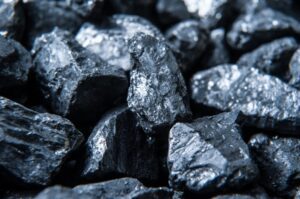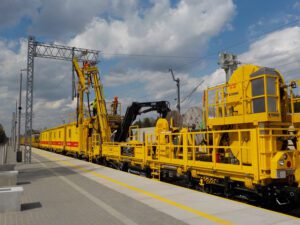
After the first test deliveries of coal to Poland in the amount of 50,000 tonnes, DTEK Energy Holding is considering the possibility of ensuring regular export of energy resources, taking into account the problems of logistics in the conditions of war, Dmytro Sakharuk, the Executive Director of DTEK, said.
“We made the first test shipments of coal to Poland. This is a small amount – 50,000 tonnes. Unfortunately, there are very big difficulties in terms of logistics, because the railway infrastructure in both Ukraine and Poland is not designed for such a volume of movement of goods. As well as ports in Poland – Gdansk and Gdynia. Therefore, there are test deliveries, but there no large volumes, as it could be done via the sea, Pivdenny port, for example,” Sakharuk said in a commentary to the Energy Reform portal.
At the same time, he assured that the company is considering the possibilities and continues to work out ways to supply coal to Poland.
“Coal from other sources is critical for Poland to replace the volume of deliveries from Russia that were banned. It would be very good if Ukraine would lend a shoulder to Poland, which helps us a lot and would help the Poles survive the rejection of Russian coal,” he said.
According to his calculations, in times of seasonal coal surplus, the energy holding could ship approximately 100,000-150,000 tonnes per month to Poland – the volume that remains after providing its thermal power plants and other consumers.
“This will not ensure full diversification of supplies, but it will be our contribution to the fact that our Polish friends will receive assistance. It is suitable in terms of quality. You just need to learn how to quickly and smoothly deliver it to Poland,” DTEK’s top manager emphasized.
At the same time, he drew attention to the fact that the supply of coal from Ukraine by rail is a faster and more economical alternative for the Poles compared to sea supplies.

Ukraine in January-April this year reduced the export of coke and semi-coke by 97.2% compared to the same period last year, to 2,532 tonnes.
According to statistics published by the State Customs Service (STS), in monetary terms, the export of coke and semi-coke over this period fell by 97%, to $758,000.
At the same time, the main exports were to Georgia (43.54% of supplies in monetary terms), Hungary (34.83%) and Turkey (21.64%).
Ukraine in January-April 2022 imported 233,003 tonnes of coke and semi-coke, which is 2.6 times more compared to January-April 2021. In monetary terms, imports increased 5.1 times, to $117.023 million. Coke was mainly imported from the Russian Federation (64.76% of deliveries in monetary terms), the Czech Republic (18.56%) and Poland (10.66%).
As reported, in 2021, Ukraine increased the export of coke and semi-coke in quantity terms by 3.3 times compared to 2020, to 194,535 tonnes. In monetary terms, the export of coke and semi-coke over this period increased 4.8 times, to $41.838 million. The products were mainly exported to Kazakhstan (29.03% of supplies in monetary terms), Turkey (20.06%) and Algeria (15.77%).
Ukraine last year imported 789,903 tonnes of coke and semi-coke, which is 2.1 times more compared to 2020. In monetary terms, imports increased 4.3 times, to $351.238 million. The products were mainly imported from the Russian Federation (65.48% of supplies in monetary terms), the Czech Republic (20%) and Poland (8.45%).
Due to hostilities in eastern Ukraine, a number of mines and coking plants occurred in territories temporarily not controlled by Ukraine.

Polish companies, with the assistance of the Polish Power Transmission and Distribution Association, handed over 20 wagons with electrical equipment to Ukrainian power engineers, the Ministry of Energy of Ukraine reported on its website on Thursday.
“Electrical equipment, power transmission towers, transformers, generators, power cables transferred by Polish companies with the assistance of the Polish Electricity Transmission and Distribution Association were transferred to seven regions of Ukraine,” the ministry said in the report.
According to the ministry, the first two batches of aid from Polish companies have already been distributed and transferred to distribution system operators in Kyiv, Odesa, Zaporizhia, Luhansk, Chernihiv, Mykolaiv, and Sumy regions. The third batch is awaiting distribution and transfer to the regions.
“We are very grateful to our Polish colleagues for their help in restoring the power infrastructure destroyed due to Russia’s military aggression against Ukraine. The equipment received, first of all, will be aimed at restoring power grids and power facilities, which were most damaged due to hostilities,” Energy Minister Herman Haluschenko said.
As the Ministry of Energy said, in total, assistance from Polish companies amounted to more than 12,500 units of equipment, including line fittings, power transformers, backup power generators, more than 400 reinforced concrete poles for power transmission lines, as well as more than 65 km and 7.3 tonnes of power cable and wires.
National bank of Ukraine’s official rates as of 19/05/22

Source: National Bank of Ukraine

Ukraine in January-April this year reduced the export of titanium-bearing ores and concentrate by 43.7% compared to the same period last year, to 129,212 tonnes.
According to statistics released by the State Customs Service (STS), in monetary terms, the export of titanium-bearing ores and concentrate decreased 18.6%, to $47.247 million.
At the same time, major exports were to the Czech Republic (50.79% of supplies in monetary terms), the United States (18.45%) and China (7.98%).
Ukraine in January-April 2022 imported 100 tonnes of similar products from Senegal for $138,000, while in January-April 2021 it imported 180 tonnes from Senegal for $160,000.
As reported, Ukraine increased the export of titanium-bearing ores and concentrate in kind by 3% in 2021 compared to 2020, to 553,051 tonnes. In monetary terms, the export of titanium-bearing ores and concentrate grew by 17%, to $161.914 million. Majot exports were to Mexico (21.23% of supplies in monetary terms), China (18.17%) and the Czech Republic (14.07%).
In 2021, Ukraine imported 1,172 tonnes of titanium-containing ores worth $1.227 million from Senegal (87.03%) and Germany (12.97%), while in 2020 it imported 1,010 tonnes worth $855,000.
In Ukraine, at present, titanium-bearing ores are mined mainly in the PJSC United Mining and Chemical Company (UMCC), under whose management the Vilnohirsk Mining and Metallurgical Plant (Dnipropetrovsk region) and Irshansk Mining and Processing Plant (Zhytomyr region) were transferred, as well as Mezhdurechensk Mining and Concentration Complex LLC and Valki-Ilmenite LLC (both LLC are located in Irshansk, Zhytomyr region).
In addition, the production and commercial company Velta (Dnipro) built a mining and concentration complex at the Birzulivske deposit with a capacity of 240,000 tonnes of ilmenite concentrate per year.
Holding company Velta Group Global Ltd. registered in London in November 2011.